
The Magnificent and Underappreciated Mighty Earthworm
February 29, 2020
By Del Ficke
“The Formation of Vegetable Mould through the Action of Worms,” by Charles Darwin, sold the greatest number of copies when Darwin was alive, according to historians.
 I recently discovered a copy and could not put it down. Darwin was writing during a time when many common people would naturally be attracted to his book because they were still gardening and connected to the earth. Darwin was a naturalist in a time of naturalists who were hungry to learn more.
I recently discovered a copy and could not put it down. Darwin was writing during a time when many common people would naturally be attracted to his book because they were still gardening and connected to the earth. Darwin was a naturalist in a time of naturalists who were hungry to learn more.
The book is an in-depth reminder and reiterates my constant championing of the earthworms as the first and best indicator that soils are becoming more balanced and returning to a more natural state. Darwin goes into amazing detail on everything from the habits and strengths of the earthworm, their importance, up to the point of reclaiming lost civilizations and how they would return even structures back to the soil.
It also covers topics such as there are certain plants, one of them being cabbage, that worms really like. My thought is, “Can we figure out in a cover crop scenario, the kind of plants they like the most and in turn speed up the growth of soil health in our crop fields?”
The culmination of all the chapters left me with this sentiment, “I thought I knew a lot about earthworms before I read this book, I really didn’t know anything at all.”

| We are still underestimating the role of the earthworm. Below are some excerpts from Darwin’s work, illustrating that fact. Worms consuming ruins of ancient buildings page 209: “Worms have also penetrated the old walls of these ruins. A wall, which had just been exposed to view during the excavations then in progress, was examined; it was built of large flints, and was 18 inches in thickness. It appeared sound, but when the soil was removed from beneath, the mortar in the lower part was found to be so much decayed that the flints fell apart from their own weight. Here, in the middle of the wall, at a depth of 29 inches beneath the old floor and of 49-and-a-half inches beneath the surface of the field, a living worm was found, and the mortar was penetrated by several burrows.” A portion of Darwin’s conclusion: “Worms prepare the ground in an excellent manner for the growth of fibrous-rooted plants and for seedlings of all kinds. They periodically expose the mould to the air and sift it so that no stones larger than the particles, which they can swallow, are left in it. They mingle the whole intimately together, like a gardener who prepares fine soil for his choicest plants. In this state, it is well-fitted to retain moisture and to absorb all soluble substances, as well as for the process of nitrification.” “When we behold a wide, turf-covered expanse, we should remember that its smoothness, on which so much of its beauty depends, is mainly due to all the inequalities having been slowly levelled by worms . . . long before he (humans) existed the land was in fact regularly ploughed by earthworms. It may be doubted whether there are many other animals which have played so important a part in the history of the world, as have these lowly organized creatures.” |
| “We commissioned Dan Kurfman to share more of his enthusiasm around Graze Master Beef with this amazing recipe. Our mouths watered just reading it. We are so thankful for our Graze Master Beef family. If you have a Graze Master Beef recipe you want to share with us, please contact our communications manager, Kerry Hoffschneider at (402) 363-8963. Thank you so much!” Del Ficke Please order your Graze Master Beef by contacting: Alyssa Ficke at 951-212-5114 or Emely Hendl at 402-613-5483. Thank you so much! |
Graze Master Beef Kafta
| By Dan Kurfman Context: When it’s summer, and the herbs and vegetables are coming in. You want something bright and flavorful, but not a lot of work. Solution: Beef Kafta, (also Kofta) an adaptation of a Mediterranean kabob more commonly done with lamb. Basic recipe ingredients: 1/4 cup of parsley 1/2 cup of small onion 1 pound of Graze Master Beef 2 teaspoons of All Spice 1/2 teaspoon of Cayenne 1/2 teaspoon of Cumin 1/2 teaspoon of Cinnamon 1/2 teaspoon of Coriander Salt and pepper to taste Basic approach: Harvest herbs, wash, drain and chop (or run through the food processor. |
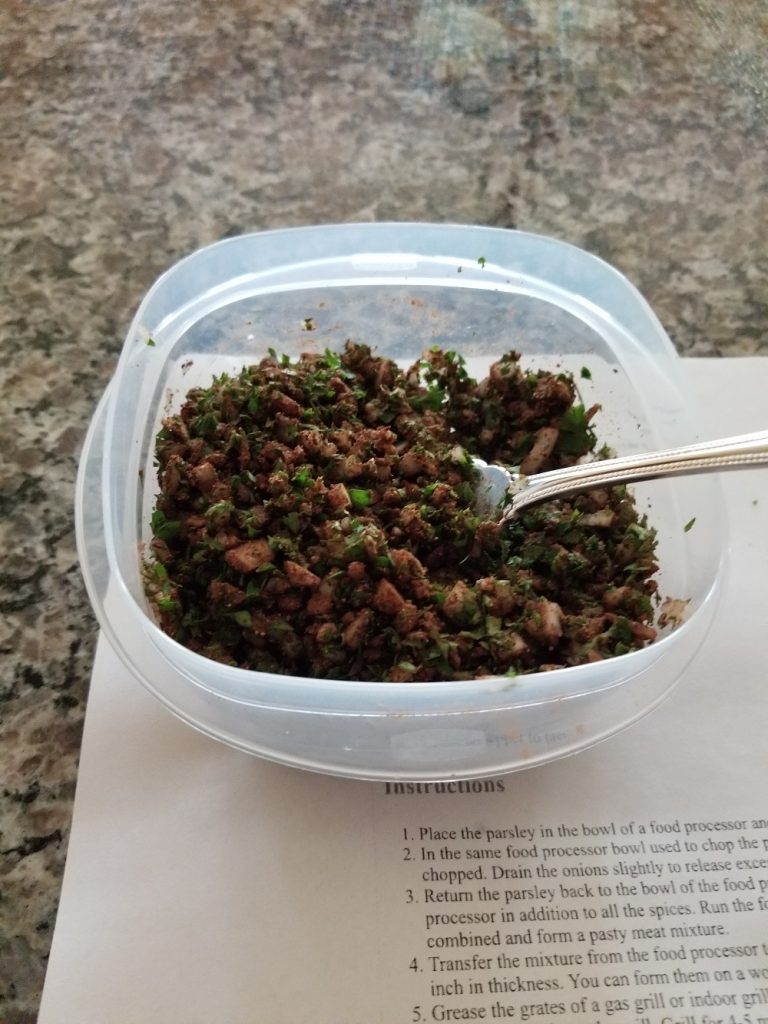
Mix with Graze Master Beef.
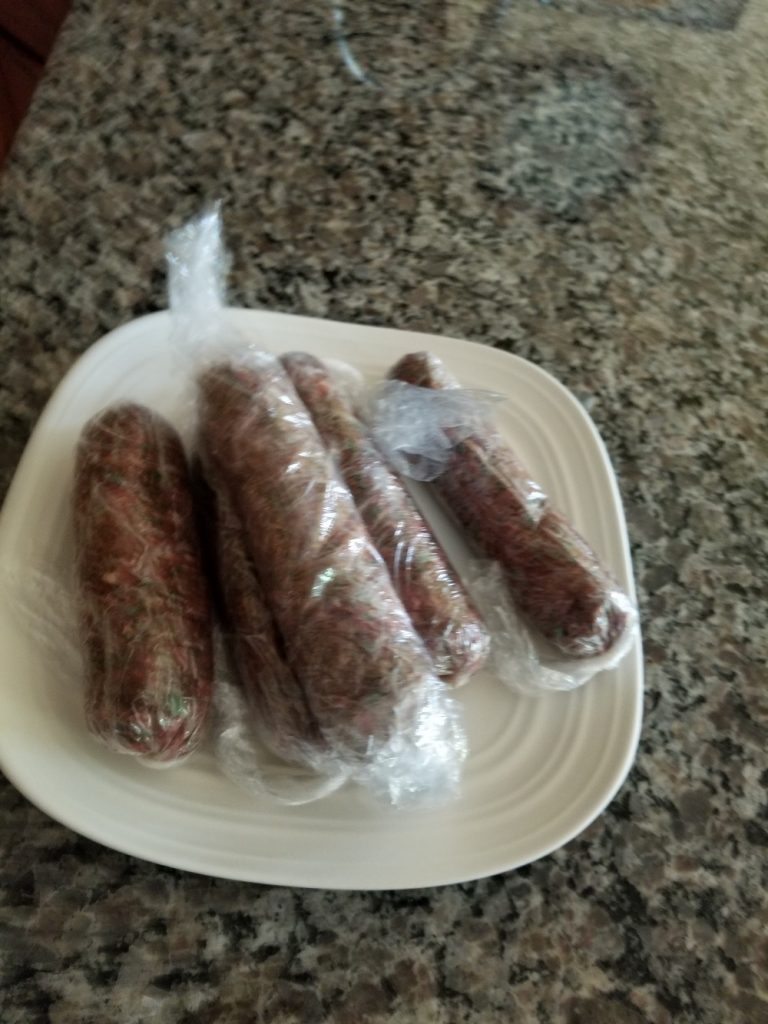
Form into shape, placing on skewers if desired. I just form into rough sausage shapes on plastic wrap, then roll up. By grabbing the ends and running across the counter like a rolling pin, the meat will form neatly and be easy to work with.
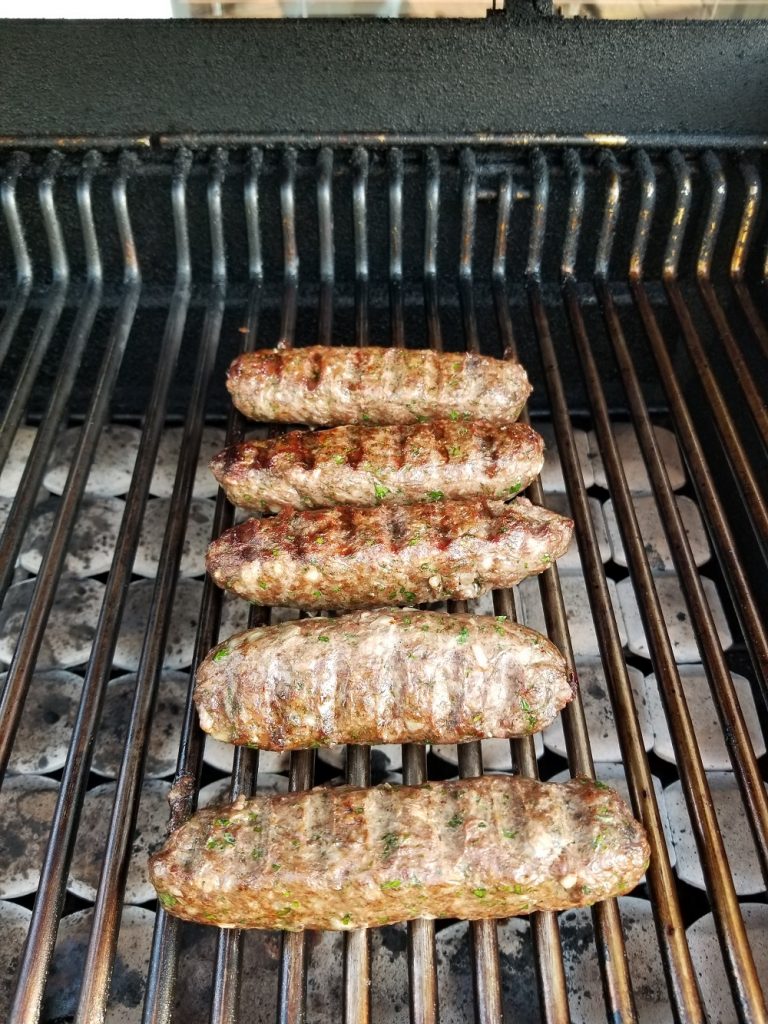
Grill to desired doneness, usually 8 to 10 minutes on my grill.

Serve with Basmati rice, sliced tomatoes and cucumbers, and a bit of Labneh. Feel free to add a bit of lemon and herbs to the Labneh. A buttermilk-ranch type dressing would probably work well too. The goal is to have a tangy, yet creamy contrast to the rich meat and bright herbs.
This sort of dish reminds us that some of the greatest blessings in life are found in simplicity and being connected to the earth.
KuneKune Gourmet Pork Available!
By Matt and Emely Hendl
Anchor Meadow Farms is very excited to announce their first batch of KuneKune Gourmet Pork is in!
“We are super excited to offer our customers this incredible, pasture-raised, heritage breed pork! We hope they notice the difference in the pork with its deep, red meat and rich marbling.” Matt and Emely Hendl
Please call Emely Hendl at 402-613-5483 for pricing, pickup and delivery information.
You can follow all the exciting Anchor Meadow Farm happenings at: https://www.facebook.com/Anchor-Meadow-Farm-245014352709769/

Pork Chops 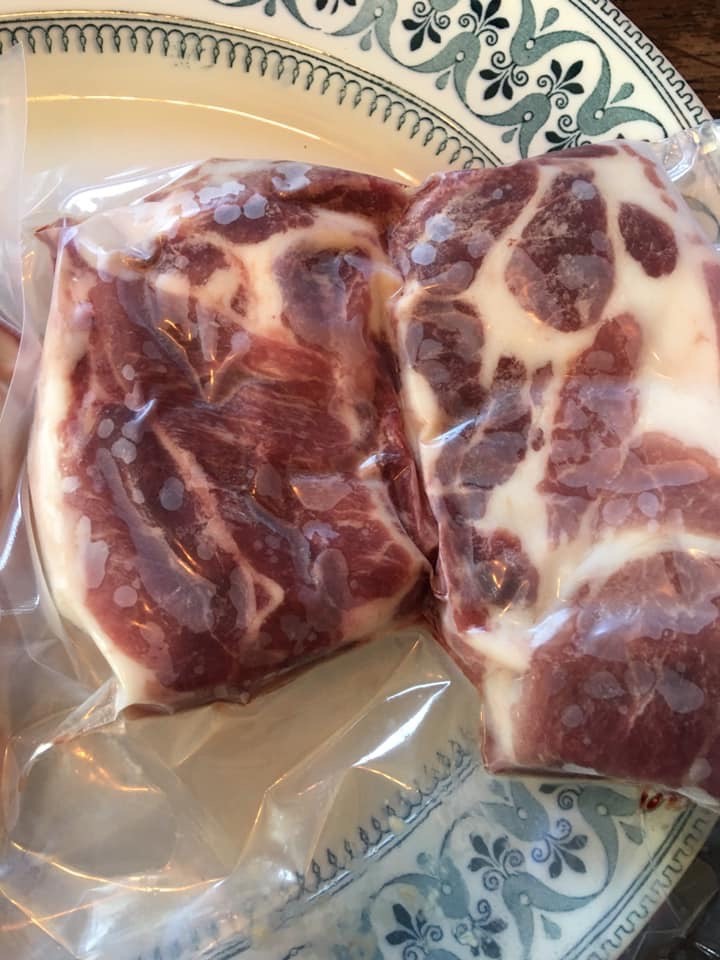
Pork Steaks 
Chorizo and Ground Italian Sausage 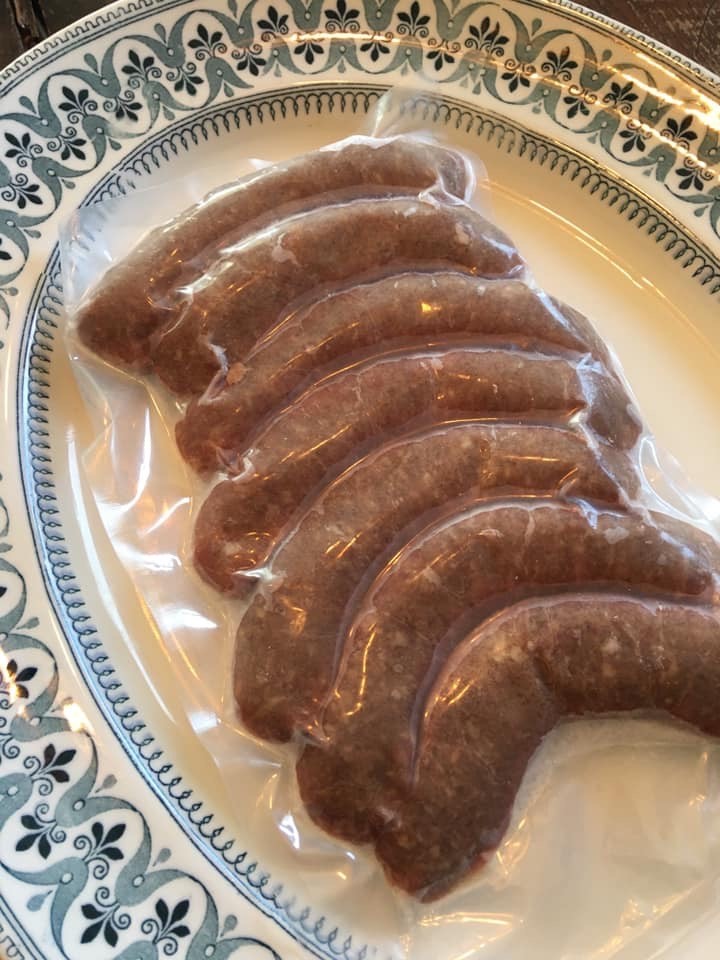
Brats 
Bacon
Hybrid 85 Demonstrating Great Results!
By Nate Belcher
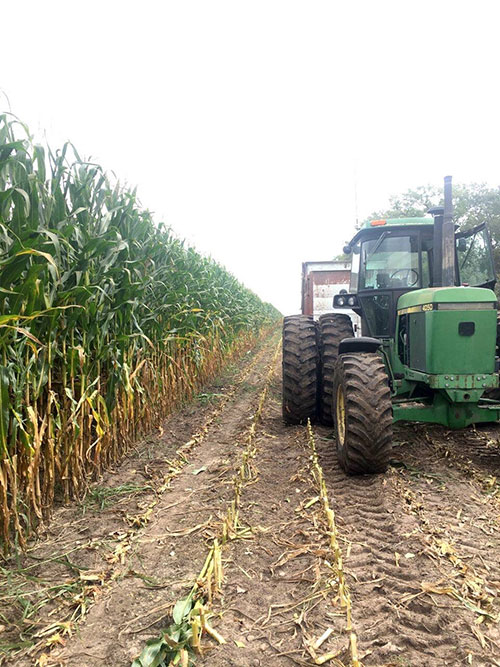 “Just a no-brainer for me,” said Bee from Nebraska. “The weeds I have, glyphosate doesn’t do a good job anyway, so it just makes sense to plant conventional, especially with the performance I saw. It sure helps out on maximizing net profit per acre.”
“Just a no-brainer for me,” said Bee from Nebraska. “The weeds I have, glyphosate doesn’t do a good job anyway, so it just makes sense to plant conventional, especially with the performance I saw. It sure helps out on maximizing net profit per acre.”
Bee from Nebraska says Hybrid 85 117-day produced, “great plant height and stand, but I was most impressed with the fantastic plant health.”
Contact Nate Belcher for more information about Hybrid 85 corn and Green Acres Cover Crops: (402) 580-0015.
“The next generation is precious. I am proud to work with Kirk Peterson and know he has the best interest of my family in mind and my descendants too.”Del Ficke
Why NOT to Name a Minor as a Beneficiary
By Kirk Peterson
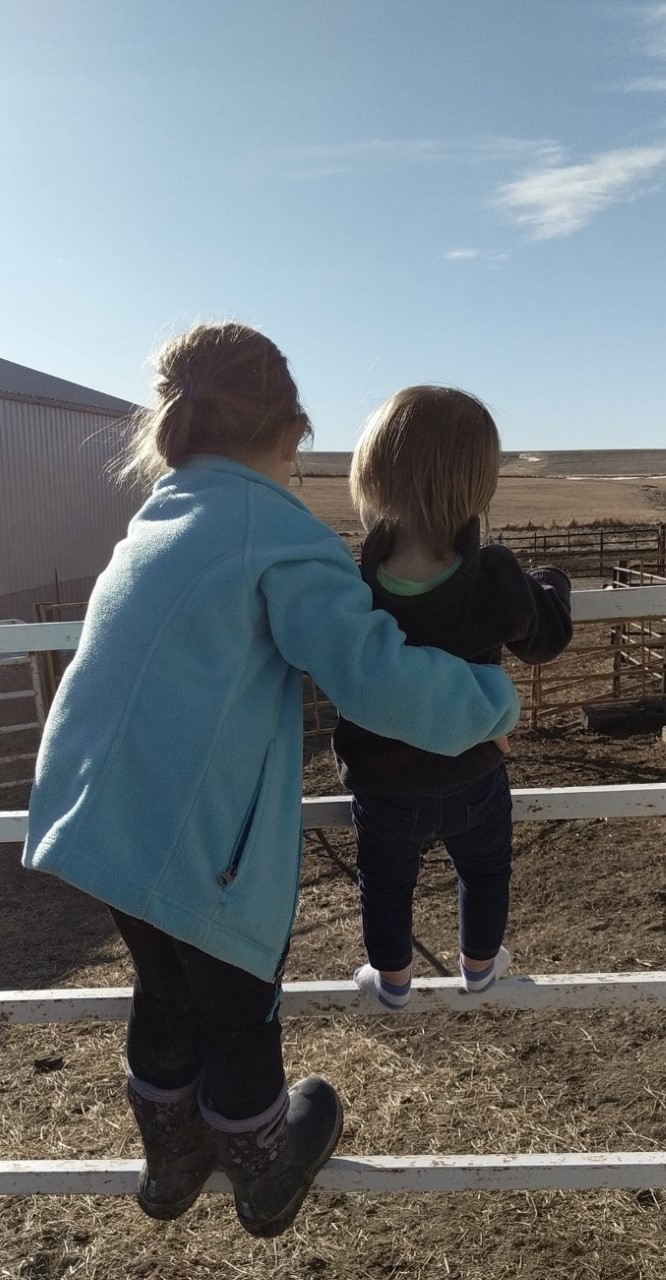 Naming children as beneficiaries for life insurance and other financial plans is common practice. However, if those children are minors, consider two downfalls:
Naming children as beneficiaries for life insurance and other financial plans is common practice. However, if those children are minors, consider two downfalls:
Your children can’t accept the proceeds until they are “of age.” This age varies by state. The money (at least a portion of it) you intended for your children’s care might be inaccessible for many years.
Once your children reach that magical age, they may receive a large amount of money all at once. Will they be mature enough to handle that? Would you have known what to do with $100,000 or more at age 18?
As an alternative, you could set up a trust for your children and name that as the beneficiary. A trust is an arrangement to manage the distribution of assets – in this case, life insurance proceeds.
Trusts can be very simple. Your attorney could draft both a trust and your will at the same time.
Five questions to ask yourself are:
How can I best pass my assets on to my family?
What role does life insurance play in estate planning?
What estate-planning steps do I need to take at my age?
Can you recommend a good estate-planning attorney?
How do I change my beneficiaries?
Give me a call at no-cost and we can explore how I can be of service to you and your family:
Kirk Peterson RICP, CFFM, FIC
kirkpeterson@woodburyfinancial.net
(402) 519-0330
118 East 2nd Street
Ainsworth, NE 69210
www.petersonassetprotectiongroup.com
“To close this newsletter, I wanted to share a bit of history. This is quite lengthy, but very much worth the read. It was a speech delivered in 1889 to the Nebraska Dairymen’s Association by Geo A. Abbott of Falls City, Neb. It is certainly filled with wisdom from the past that is applicable to today. Thank you for reading and for your support of our efforts.” Del Ficke
Grass
Geo A. Abbott’s speech delivered in 1889 to the Nebraska Dairymen’s Association
 More than 30 years ago, when the white man made his first appearance upon the rich, billowy prairies of Richardson County, he found a soil rich beyond conception in plant food, the result of countless ages of accumulation, a veritable “Nature’s Strong Box” which had only to be unlocked with the plow to yield an abundance of golden harvests. Year after year, without any return to the soil in the way of fertilizers, our farmers have continued to draw exhausting crops of the cereals from the ground, shipping them to markets.
More than 30 years ago, when the white man made his first appearance upon the rich, billowy prairies of Richardson County, he found a soil rich beyond conception in plant food, the result of countless ages of accumulation, a veritable “Nature’s Strong Box” which had only to be unlocked with the plow to yield an abundance of golden harvests. Year after year, without any return to the soil in the way of fertilizers, our farmers have continued to draw exhausting crops of the cereals from the ground, shipping them to markets.
This skimming process, together with the drifting winds of winter and the washing rains of summer, has been continued, until today, measured by their productive capacity, our hill soils are worth but little more than half as much as they were 30 years ago. And, while our farmers may point with pride to their palatial residences, magnificent barns, and respectable bank accounts as evidence of their success, they seem to forget the fact that these things are only the original wealth of the soil, metamorphosed into new shape and substance; that if they should strike a balance, taking into account the impoverished condition of their fields, they are but little better off than they were 30 years ago, when these splendid improvements were held locked in the unmortgaged bosom of the soil.
How then, may we make a substantial growth and at the same time restore to our famished lands their original fertility? The answer is found in the one-word – GRASS.
As illustrative of the advantages of grass farming over grain farming, permit me to cite one of the many instances that have come under my immediate observation. About 15 years ago, one of my neighbors who was blessed with sufficient foresight to penetrate the future and discern whither we were drifting, began sowing a major portion of his farm to grass and to gradually stock it up. While the hum of the thresher and sheller were heard at the farms of others, who with long lines of teams, were carting away to a glutted corn and wheat market the cream of their soil – he, with his flocks and herds, was marching along a surer road to fortune. Today, he is proud owner of two fine farms, three-fourths of which are kept constantly in grass, covered with several hundreds of thoroughbred sheep, together with large herds of fine horses, cattle and hogs.
Result: he and the mortgage fiend have long since parted company, and the preserved fertility of his soil is evidenced by the superior abundance of its yield and the absence of foul and noxious weeds; besides all along the line of his life he is in the constant enjoyment of that peace of mind which can come to the husbandman only from contemplation of grassy fields, lowing and bleating flocks, and the knowledge of the fact that the wolf is far removed from his door.
One other instance I hope I may be permitted to cite without subjecting myself to the charge of egotism. For a long time, I did what a great many others did and are still doing. I followed the more exhaustive system of grain farming with its resultant concomitant, interest paying; but “whom the Lord loveth He chasteneth,” and in 1883 there came a great flood down the valley on which my farm (which consists chiefly of bottom land) is situated, overflowing and drowning out a large percentage of my crops.
I then concluded to put into practice a plan which I had for some time been contemplating, that of starting a horse ranch. So, the following fall, I sowed 12 acres of timothy and red clover and have added to these acres since, until now all my farm is in grass but about 40 acres. The result is I have more horses than I can ride, have long since made my parting salaams to the mortgage fiend, am beginning to suspect that I may in time become one myself. As, I frequently catch myself asking the question if the usury laws which prevent us from charging our neighbors two percent a month for the use of our surplus cash may not after all stand in the way of our best interests and highest possible development of the country.
Suppose any gentleman present should conclude to quit farming and embark in the mercantile business. Making a sale of his effects he finds himself with $10 or $20,000; he invests in dry goods and begins to sell them. He follows the same line of policy he did on the farm – that is, he continues day after day to draw his shelves and throw on the market his original supply, never replenishing, never returning anything to his shelves, but from day to day living upon the proceeds of his sales; how long will it be until he is bankrupt?
I venture the assertion, and defy contradiction, that no business on earth will stand as much mismanagement, as much neglect, as much exhausting and as little replenishing as farming. But even our richest soils will in time become impoverished, as one may plainly see by visiting some of the older hill fields in this county. If, at the end of 30 years, we find what we at one time thought was an inexhaustible supply of plant food greatly diminished and a mortgage upon the remainder, what may we expect 30 years hence?
In the past we have not known what it was, to lay out large sums annually for costly commercial fertilizers, hence we have been able to compete, although at a distance from the market, with the worn out fields of the east; and if we are wise and begin, ere it is too late, a judicious system of grassing our lands, we may restore the partially exhausted fertility of our soils. Grass means stock, and stock means barnyard manures, which may be utilized advantageously, but the chief fertilization will come from the grass itself.
If anyone doubts this let him sow one of his fields to grass and after a few years break it up again, and he will be astonished at the yield of corn or wheat. There is another advantage, in my judgment, to be derived from grassing of lands, in the stating of which I know I am running counter to the generally accepted theory. It is this: the restoration of the underground water supply to our wells and springs. It is a well-established fact that as countries get older and are brought under the dominion of the plow, springs and wells dry up.
In the early settlement of Illinois, the prairie portions were found to be almost one continuous swamp or bog, and good wells could be had by sinking from 5 to 15 feet almost anywhere, the country could not be successful until it was tiled, and the tilings ran full and flush with water the year-round like so many living springs, but I am informed by parties from there that of late years those tile ditches are dry nearly all the time, that the wells have had to be sunk deeper and the country is surely getting drier. If then, as according to the accepted theory, more of the rainfall is absorbed into the ground after it has been broken and plowed than before, why do not those tile ditches show an increased water flow, and the wells hold out their water supply?
In 1841, my father emigrated to what was then known as the “Platte Purchase” in Missouri. We found almost every draw or swale running with “Spring branches,” as they were called, and wherever there were pools of deep water, we found an abundance of fish, proving conclusively that the supply of water in those draws and pools must have been constant or fish could not have grown and lived there. In 15 years, those draws had all become dry, except immediately after rains, and there used to be bold running streams and none are now found, and wells that once furnished an abundance of water at a depth of 15 to 20 feet below the surface have entirely failed and have had to be dug deeper. When I settled in this county in 1862, I thought then that it was the best watered county I had ever seen. Now I can take any one of dozens of places in a radius of ten miles where bold flush springs used to run and find them as dry as a powder house.
Mr. F. W. Ingham, the proprietor of our windmill and well factory, and whom I consider the best authority in our county upon the subject of water supply, informs me that there are very few wells of 10 years standing in this county but have either gone entirely dry, or show a permanent decrease in water supply, while he has constant calls to sink wells deeper in search of water where the supply was at one time thought to be inexhaustible. I found on my farm, when I settled it, a number of “wet weather” springs, and also some considered permanent, before the prairies on the highlands above me were broken; since those uplands have been brought under cultivation my “wet weather” springs have all dried up. I can cultivate right over the land where they were; the permanent springs show a decreased flow.
Again I ask, if a larger percent of the rainfall enters the earth now than did before the sod was broken, and the amount of rainfall has increased as these self-styled learned men tell us, why do we not find more “wet weather” springs and a greater supply in our wells and permanent springs? It devolves upon the wise-acres, who believe in the established theory that the rainfall and rain absorption is increasing, to answer these questions and account for the well-established fact that countries get drier as they get older.
I know we have some gentlemen, with the handle of professor to their names, who have made the remarkable discovery, and tell us in a very learned way that a cubic foot of earth taken from a wet corn field has been found to weigh more than a cubic foot of earth taken from a dry prairie, and hence plowed ground absorbs a greater percent of the rainfall than grasslands; and to the superficial thinker this will at first sight appear true. But this theory cannot account for the facts as we find them; that floods are becoming more frequent in our water courses, and that the underground runs and reservoirs of water, which must receive their supply from surface absorption, are drying up and failing. Break the sod and the grass roots decay.
What rainfall does not flow away to make the floods is retained near the surface and the lower earth or subsoil becomes dry and your wells fail. I have been asked, what will renters do who are not able to follow grass farming, which necessitates the keeping of stock? I will answer, he will have to go on skimming the ground and raising cockleburs and tramps unless the owners of the land have sufficient good sense to make other terms with them and furnish them with stock.
A man who commenced 30 years ago to make his farm finds himself now, if he has been economical, with a comfortable home, and if he has acted wisely, also with good improvements and a preserved fertility of soil; but he also finds he is getting old and not able to work as he once did. He wants to retire – he is offered $400 or $500 a year by some strong, young man for the use of his farm, a bargain is made, and the sapping process is commenced. The farm is worth $10,000, it represents the old man’s capital – he gets $500 per annum, or 5 percent. But, at the end of a few years, he begins to realize that it is not the interest on his principal itself. He finds his farm rundown – where once were fertile fields, are now poor fields.
Hence, if our wealthy, retired farmers will be wise in time they will grass their farms, stock them up, and place them in the hands of trusty men on shares, thus holding a certain right of supervision that will not only enable them to preserve the fertility of their lands – but, in the end, receive a great dividend upon their investment.
Thank you for reading and thank you for your support.

